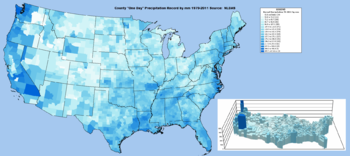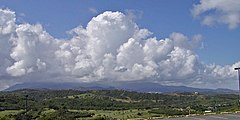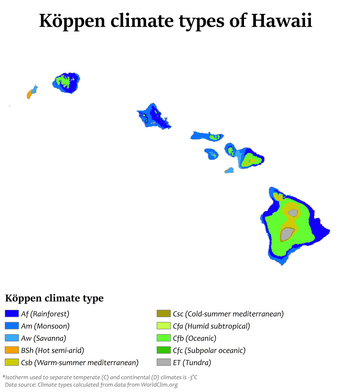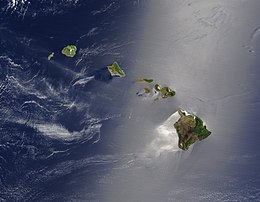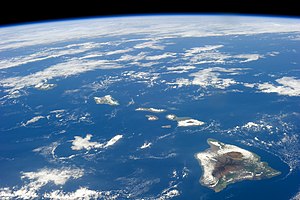Köppen climate types of the U.S. (50 states, District of Columbia, and 5 inhabited U.S. territories)
The climate of the United States varies due to changes in
latitude, and a range of geographic features, including mountains and
deserts. Generally, on the mainland, the climate of the U.S. becomes
warmer the further south one travels, and drier the further west, until
one reaches the West Coast.
West of the 100th meridian, much of the U.S. has a cold semi-arid climate in the interior upper western states (Idaho to Dakotas), to warm to hot desert and semi-arid climates in the southwestern U.S. East of the 100th meridian, the climate is humid continental
in northern areas (locations roughly above 40 north latitude, Northern
Plains, Midwest, Great Lakes, New England), transitioning into a humid temperate climate from the Southern Plains and lower Midwest east to the Middle Atlantic states (Virginia to southern Connecticut).
A humid subtropical climate is found along and south of a mostly east-west line from the Virginia/Maryland capes (north of the greater Norfolk, Virginia area), westward to approximately northern Oklahoma, north of the greater Oklahoma City area. Along the Atlantic seaboard, the humid subtropical climate zone extends southward into central Florida. A Mediterranean climate prevails along most of the California coast, while southern Florida has a tropical climate, the warmest region on the US mainland. Hawaii and the U.S. territories also have tropical climates.
Higher-elevation areas of the Rocky Mountains, the Wasatch Range, Sierra Nevada, and Cascade Range are alpine. Coastal areas of Oregon and Washington have an oceanic climate. The state of Alaska, on the northwestern corner of the North American continent, is largely dominated by a subarctic climate, but with a subpolar oceanic climate in the southeast (Alaska Panhandle), southwestern peninsula and Aleutian Islands, and a polar climate in the north.
The primary drivers of weather in the contiguous United States
are the seasonal change in the solar angle, the migration north/south of
the subtropical highs, and the seasonal change in the position of the
polar jet stream.
In the Northern Hemisphere summer, the subtropical high pressure systems move northward and closer to the United States mainland. In the Atlantic Ocean, the Bermuda High
creates a south-southwest flow of tropical air masses over the
southeastern, south-central and central United States - resulting in
warm to hot temperatures, high humidity and frequent intense (but
usually brief) showers and/or thunderstorms as the heat builds in the afternoon. In the Northern Hemisphere summer, high pressure in the Pacific Ocean
builds toward the California coast, resulting in a northwesterly
airflow, creating the cool, dry, and stable weather conditions prevalent
along the West Coast in summer.
In the Northern Hemisphere winter, the subtropical highs retreat
southward. The polar jet stream (and associated conflict zone between
cold, dry air masses from Canada and warm, moist air masses from the
Gulf of Mexico) drops further southward into the United States -
bringing more frequent periods of stormy weather, with rain, ice and
snow, and much more variable temperatures, with rapid temperature rises
and falls not uncommon. Areas in the southern U.S. (Florida, the Gulf
Coast, the Desert Southwest, and southern California) however, often
have more stable weather, as the polar jet stream's impact does not
usually reach that far south.
Weather systems, be they high-pressure systems (anticyclones),
low-pressure systems (cyclones) or fronts (boundaries between air masses
of differing temperature, humidity and most commonly, both) are
faster-moving and more intense in the winter/colder months than in the
summer/warmer months, when the belt of lows and storms generally moves
into southern Canada.
The Gulf of Alaska is the origination area of many storms that enter the United States. Such "North Pacific lows" enter the U.S. through the Pacific Northwest, then move eastward across the northern Rocky Mountains, northern Great Plains, upper Midwest, Great Lakes and New England
states. Across the central states from late fall to spring, "Panhandle hook"
storms move from the central Rockies into the Oklahoma/Texas panhandle
areas, then northeast toward the Great Lakes. They generate unusually
large temperature contrasts, and often bring copious Gulf moisture
northward, resulting sometimes in cold conditions and possibly-heavy
snow or ice north and west of the storm track, and warm conditions,
heavy rains and potentially-severe thunderstorms south and east of the
storm track - often simultaneously.
Across the northern states in winter usually from Montana
eastward, "Alberta clipper" storms track east and bring light to
moderate snowfalls from Montana and the Dakotas across the upper Midwest
and Great Lakes states to New England, and often, windy and severe
Arctic outbreaks behind them. When winter-season Canadian cold air
masses drop unusually far southward, "Gulf lows" can develop in or near
the Gulf of Mexico, then track eastward or northeastward across the
Southern states, or nearby Gulf or South Atlantic waters. They sometimes
bring rain, but can bring snow or ice across the South, mostly in
interior or northern areas.
In the cold season (generally November to March), most
precipitation occurs in conjunction with organized low-pressure systems
and associated fronts. In the summer, storms are much more localized,
with short-duration thunderstorms common in many areas east of the 100th
meridian and south of 40 latitude.
In the warm season, storm systems affecting a large area are less
frequent, and weather conditions are more solar {sun} controlled, with
the greatest chance for thunderstorm and severe weather activity during
peak heating hours, mostly between 3 PM and 9 PM local time. From May to
August especially, often-overnight mesoscale-convective-system (MCS)
thunderstorm complexes, usually associated with frontal activity, can
deliver significant to flooding rainfall amounts from the
Dakotas/Nebraska eastward across Iowa/Minnesota to the Great Lakes
states.
From late summer into fall (mostly August to October), tropical cyclones
(hurricanes, tropical storms and tropical depressions) sometimes
approach or cross the Gulf and Atlantic states, bringing high winds,
heavy rainfall, and storm surges (often topped with battering waves) to
Gulf and Atlantic lowlands and coastal areas.
Record one day precipitation by county between 1979 and 2011.
A map of the average annual high temperatures in the United States.
Regional overview
Southwest
The Southwest has a hot desert climate, at lower elevations. Cities like Phoenix, Las Vegas, Yuma, and Palm Springs
have average highs over 100 °F (38 °C) during the summer months and
lows in the 70s or even 80s. In winter, daily temperatures in the
southwest are cooler with highs in the 50s and 60s F, and lows in the
40s F.
In Phoenix, Las Vegas and similar Southwestern desert areas, on
average June is the driest month, after Pacific-originating winter
storms have concluded and before the Southwestern summer "monsoon"
begins. The Southwest and the Great Basin are affected by said monsoon
from the Gulf of California from July–September. This results in some
increase in humidity and cloud cover, bringing higher nighttime low
temperatures and localized thunderstorms to the region, which can result
in flash flooding. Further eastward in the desert Southwest (Tucson,
AZ eastward toward El Paso, TX), winter-season precipitation decreases,
while the summer monsoon increasingly provides a summer precipitation
maximum. For example, El Paso and Albuquerque, NM
have a pronounced July to September precipitation maximum. Still,
drought has been frequent in the region, often lasting for periods of
years or longer. Forest fires across the Western United States
(especially the southwest) occur many years, and can be severe to
extreme in especially hot, dry summer seasons.
Northern Arizona and New Mexico, central and northern Nevada and most
of Utah (outside higher mountain areas) have a temperate semi-desert to
desert climate, but with colder and snowier winters than in Phoenix and
similar areas, and less-hot summers (as at Salt Lake City,
Utah). Summer high temperatures often reach the 90s, but low
temperatures drop into the low 60s and even 50s. As in other temperate
desert climates, the dry air results in large differences (sometimes
over 40 degrees) between daytime high and nighttime low temperatures.
Precipitation, though scarce, often falls year-round, influenced both by
summer thunderstorms brought by the Southwestern monsoon (primarily in
southern areas), and by winter-season storms from the Pacific Ocean.
The coast of California has a Mediterranean climate.
Daily high temperatures range from 70 to 80 °F (21 to 27 °C) in the
summer to 50 to 65 °F (10 to 16 °C) in winter, with low temperatures
from the 60 °F (16 °C)s in summer to the mid 40s F in winter.
Like most Mediterranean climates, much of coastal California has a wet
winter and dry summer. Early summers can often bring cool, overcast
weather (fog and low stratus clouds) to coastal California. As such, the
warmest summer weather is delayed until August, even September in many
areas of the California coast; on average, September is the warmest
month in San Francisco,
CA. Upwelling of cold Pacific waters also contributes to the frequent
cool spring and early summer weather in coastal California. In
California's inland river valleys (Bakersfield, Sacramento
areas), the wet-winter, dry-summer pattern remains, but winters are
cooler and more prone to occasional frost or freeze, while summers are
much hotter, with blazing sunshine and daytime high temperatures not
uncommonly in the 90s °F to over 100 °F (38 °C).
Gulf Coast/Lower Mississippi Valley/South Atlantic states
The Gulf and South Atlantic states have a humid subtropical climate with mostly mild winters and hot, humid summers. Most of the Florida peninsula including Tampa and Jacksonville, along with other coastal cities like Houston, New Orleans, Savannah, GA, Charleston, SC and Wilmington, NC
all have average summer highs from near 90 to the lower 90s F, and lows
generally from 70 to 75 °F (21 to 24 °C); combined with moist tropical
air, this creates the sultry summer weather conditions that prevail
here.
Swamp in southern Louisiana
In the interior South, in cities like Raleigh, NC, Atlanta, Birmingham, AL, Nashville, TN and Jackson, average summer highs and lows are similar to coastal areas, while some areas of interior eastern and central Texas (i.e. Dallas, Austin and San Antonio
areas) have average daily highs in the mid to upper 90s F. In winter,
average daily high temperatures range from the 40 °F (4 °C)s (upper
South: northern Arkansas, Kentucky and Virginia), to the 60 °F (16 °C)s
along the Gulf Coast and South Atlantic coast (Charleston southward),
with 70 °F (21 °C)s in central Florida and far southern Texas. Average
daily lows in winter range from 20 °F (−7 °C)s north to 40 °F (4 °C)s
along the Gulf and far South Atlantic coasts, with 50 °F (10 °C)s in
Florida and coastal south Texas.
Much of the interior South (Tennessee, Kentucky and the northern
Gulf states) has a winter or spring maximum in precipitation, with
December, March or April typically the wettest month, and August to
October the driest months - for example, at Birmingham, AL, Huntsville, AL, Tupelo, MS and Memphis, TN.
From November to April, these areas commonly experience sharp conflicts
between cold, dry air from Canada and warm, moist air from the Gulf of
Mexico. These air-mass clashes often bring heavy winter and spring
precipitation to the Mid-South.
Given the tropical air masses, summer-season thunderstorms can occur
throughout the South, but they are heavier and more frequent along the
Gulf Coast, South Atlantic coast (Norfolk, VA area southward), and in
peninsular Florida. Along most of the Gulf coast (i.e. New Orleans, LA, Mobile, AL and Pensacola, FL areas), and in South Atlantic coastal and sandhills areas (i.e. Columbia, SC, Fayetteville, NC, Raleigh, NC, Wilmington, NC, and Norfolk, VA),
July and August are usually the wettest months, and precipitation is
fairly evenly distributed the rest of the year. Primarily from August to
early October, the coastal Gulf and South Atlantic states are
susceptible to being struck by tropical weather systems (tropical
depressions, tropical storms, and hurricanes). Even in winter, most
precipitation falls as rain. However, occasionally frozen precipitation
(snow, sleet and/or freezing rain) can occur (more commonly in interior
and northern areas) when southerly-tracking storms throw Gulf or
Atlantic moisture over cold air at ground level.
Southern Florida has a tropical climate,
with all months having a mean temperature of higher than 65 °F (18 °C),
a wet season from May through October, and a dry season from November
through April. In cities like Fort Lauderdale, Miami, Key West, Naples, and Palm Beach
average daily highs range from the mid 70 °F (21 °C)s in winter to near
90 °F (32-33 °C) in summer. Average overnight lows range from the upper
50 °F (10 °C)s in winter to the mid and upper 70 °F (21 °C)s in summer.
Southern Florida is the warmest region of the U.S. mainland in winter.
Southern Plains/Lower Midwest/Middle East Coast
The
region from the southern Plains, to the lower Midwest, eastward to the
central East Coast (the New York City/coastal Connecticut region
southward to Virginia) has a temperate climate
climate with cool to cold winters and hot, humid summers. Daytime highs
range from 80 to 90 °F (27 to 32 °C) in summer to 35 to 50 °F (2 to
10 °C) in winter. Lows range from the 60 °F (16 °C)s in summer to 25 to
35 °F (−4 to 2 °C) in winter. Cities in this region include Wichita, KS, St. Louis, MO, Springfield, IL, Indianapolis, IN, Columbus, OH, Pittsburgh, PA, Philadelphia, PA, Washington, D.C., Richmond, VA, New York City, NY, New Haven, CT, and Atlantic City, NJ.
Precipitation is spread fairly evenly throughout the year, though as
one travels from Indiana westward there is an increasingly prominent
early-summer concentration, with a May maximum in northern Texas and
Oklahoma, and a June maximum increasingly evident from
(central/northern) Indiana westward to Kansas. As one travels from east
to west across Texas, Oklahoma and Kansas, average annual precipitation
steadily decreases. Far western Texas (El Paso
area) is desert, and average annual precipitation is less than twenty
inches (510 mm) in westernmost Kansas and the Oklahoma Panhandle, where
the climate qualifies as semi-arid.
In the lower Midwest (and southern Plains states, especially),
temperatures can rise or drop rapidly; winds can be extreme; and
clashing air masses, including hot, dry air of Mexican and/or
Southwestern origin, warm, moist air from the Gulf of Mexico and cold,
dry air from Canada can spawn severe thunderstorms and tornadoes,
particularly from April to June. The "dryline,"
separating hot, dry air of Mexican/Southwestern U.S. origin from warm,
moist air from the Gulf of Mexico, often causes severe, occasionally
violent, thunderstorms to fire in central and eastern Texas, Oklahoma
and Kansas; these sometimes contribute toward the hailstorms and tornado outbreaks that the Southern Plains are well known for. Reflecting these air-mass conflicts, central Oklahoma, including the Oklahoma City and Moore-Norman
areas, has the highest frequency of tornadoes per unit land area on
planet Earth, with May the highest-risk month for tornadoes throughout "Tornado Alley," from northern Texas north-northeastward toward western and central Iowa.
Northern Great Plains/North-Central/Great Lakes/New England
The northern half of the Great Plains (Nebraska northward), northern Midwest, Great Lakes, and New England states have a humid continental climate.
Here there are four distinct seasons, with warm to hot summers, and
cold and often-snowy winters. Average daily high temperatures range from
10 °F (−12 °C)s (in North Dakota, and central and northern Minnesota)
to 30 °F (−1 °C)s in winter to 70 to 80 °F (21 to 27 °C)s in summer,
while overnight lows range from below 0 °F (−18 °C) in winter (in North
Dakota and much of Minnesota) to 50 to 60 °F (10 to 16 °C)s in summer.
In the New England states, precipitation is evenly distributed around
the year, with a slight late fall-early winter (November–December)
maximum along the New England coast from Boston, MA northward due to
intense early-winter storms. In the Great Lakes states, cold Arctic air
in winter crossing the relatively warmer lake waters can result in
frequent and sometimes very heavy lake-effect snow,
especially on the eastern and southern shores of the Great Lakes (for
example, in western Michigan's Lower Peninsula and in the Buffalo, NY
area). Cities in this area include Minneapolis, MN, Omaha, NE, Sioux Falls, SD, Fargo, ND, Chicago, IL, Cleveland, OH, Buffalo, NY, Albany, NY, Boston, MA, Concord, NH and Augusta, ME.
As one travels from east to west across Nebraska, South Dakota and
North Dakota, average annual precipitation steadily decreases, and the
westernmost counties of these states have a semi-arid climate, with
about or just over 15 inches of precipitation per year, on average (see
climate data for Williston, ND, Rapid City, SD and Scottsbluff, NE).
In the upper Midwest and northern Plains states, temperatures may
rise or fall rapidly, and winds (from warm-season thunderstorms or
larger-scale low-pressure systems) can be strong to extreme. Here,
air-mass conflicts primarily involve warm, moist air from the Gulf of
Mexico, clashing with cool to cold, dry air from Canada, with only
occasional intrusions of hot, dry air from the southwest. The conflicts
between Canadian and Gulf air commonly produce severe thunderstorms
(including hailstorms, especially on the western Plains) and tornadoes,
particularly in May and June. In the northern Plains and North Central
states generally, June is the year's wettest month on average, owing to
maximum shower and thunderstorm activity. Also, June is the highest-risk
month for severe weather throughout North Dakota, South Dakota,
Minnesota, Iowa, Wisconsin and northern Illinois.
Pacific Northwest
Cascade Range in Washington
The Pacific Northwest has an oceanic climate.
The climate is wet and cool in autumn, winter, and spring, and stable
and drier in the summer months, especially July and August. On average,
the wettest month is typically November or December; the driest, July.
In the summer months, average highs in cities like Seattle and Portland
are from 70 to 75 °F (21 to 26 °C) with lows from 50 to 59 °F (10 to
15 °C), while in winter daily highs are from 40 to 45 °F (4 to 9 °C) and
overnight lows from 30 to 38 °F (−1 to 4 °C).
In winter, the Pacific Northwest
(especially coastal districts and other areas west, i.e. on the
prevailing windward side, of the Olympic and Cascade mountain ranges),
experiences a mostly overcast, wet and cool climate, but without severe
cold like that found in the interior northern U.S. (i.e. Minnesota/North
Dakota). At lower elevations, winter precipitation falls mostly as
rain. However, snow does occur even at the lowest elevations, primarily
when Pacific moisture interacts with cold air intruding into the Pacific
Northwest from western Canada (i.e. Alberta and interior British
Columbia). Summers in the Pacific Northwest are generally cool,
especially along the coastline. The Great Basin and Columbia Plateau
(the Intermontane Plateaus) are arid or semiarid regions, with high
summer temperatures in the 90s to occasionally over 100 at lower
elevations (e.g. at Boise, ID),
with annual precipitation averaging less than 15 inches (380 mm) as a
result of the rain shadow of the Sierra Nevada and Cascades.
Both coastal and interior areas of Oregon and Washington, and southern
Idaho, have a wet-winter, dry-summer precipitation pattern, but
traveling eastward into Montana and Wyoming, this transitions
progressively (for example, at Missoula, MT)
toward relatively drier winters and a May and eventually June
precipitation maximum, the latter characteristic of the Northern Plains
and much of the upper Midwest (i.e. both Dakotas, Nebraska, Iowa and
Minnesota).
Alaska
The climate in Juneau and the southeast panhandle is a mid-latitude oceanic climate (Köppen Cfb). The climate in the extreme north of Alaska is what would be expected for an area north of the Arctic Circle — it is an Arctic climate (Köppen ET) with long, very cold winters and short, cool summers.
Akclimate.org says the following: "The altitude above sea level
influences the climate of a given area [in Alaska]. Lower elevations in
interior Alaska, such as the Yukon Flats and the Tanana Valley
experience extreme cold in the winter as well as high summertime
temperatures."
Hawaii
Hawaii has a tropical climate. Though Hawaii is tropical, Hawaii has several different climates at different altitudes. Snow sometimes occurs at the highest elevations in Hawaii. The following was said about Hawaii's climate:
"Hawaii boasts 11 of the 13 climate zones in the world, each with unique ecosystems and weather characteristics. Factors such as elevation, pressure variations, rainfall, wind and topography combine to create distinctive locations throughout the islands."
Caribbean territories
Puerto Rico has different climatic zones, all tropical. The northeastern part of the territory is very wet, with a tropical rainforest climate (Köppen Af). This supports rainforests like El Yunque. The southern part is drier, mostly a savanna climate (Köppen Aw) with small locations on the southern coast dry enough to have a hot-semi arid climate (Koppen BSh).
The U.S. Virgin Islands have a tropical savanna climate, with warm, dry winters, and rainy summers (Köppen Aw), typical of the Caribbean. The wet season is from May to October.
In 2015, the Wall Street Journal reported that U.S. territories such as Puerto Rico are the areas of the U.S. most vulnerable to climate change.
Pacific territories
A view of Ofu Beach on Ofu Island in American Samoa
Guam and the Northern Mariana Islands both have a trade-wind tropical rainforest climate (Köppen Af). The dry season is from January to May, and the wet season from July to November.
American Samoa
is south of the equator, and therefore its wet/dry seasons are
reversed. The wet season is from December-March, and the dry season is
from April-September. Rainmaker Mountain on Tutuila traps trade-wind rainclouds, leading to very high rainfall and a tropical rainforest climate (Köppen Af).
Precipitation
Average precipitation
Precipitation (whether by annual amount, annual distribution or characteristic[s]) varies significantly across the United States and its possessions. Late summer and fall extratropical cyclones bring a majority of the precipitation which falls across western, southern, and southeast Alaska annually. During the fall, winter, and spring, Pacific storm systems bring most of Hawaii and the western United States much of their precipitation. Most of Florida has a subtropical monsoon rainfall pattern (wet summer and dry winter).
In the central and upper eastern United States, precipitation is
evenly distributed throughout the year, although summer rainfall
increases as one moves southeastward. Lake-effect snows add to
precipitation potential downwind of the Great Lakes, as well as Great Salt Lake and the Finger Lakes
during the cold season. The average snow to liquid ratio across the
contiguous United States is 13:1, meaning 13 inches (330 mm) of snow
melts down to 1 inch (25 mm) of water. The El Niño-Southern Oscillation
affects the precipitation distribution, by altering rainfall patterns
across the West, Midwest, the Southeast, and throughout the tropics.
During the summer, the Southwest monsoon combined with Gulf of California and Gulf of Mexico moisture moving around the subtropical ridge
in the Atlantic Ocean bring the promise of afternoon and evening
thunderstorms to the southern tier of the country as well as the Great Plains. Equatorward of the subtropical ridge, tropical cyclones enhance precipitation (mostly from August to October) across southern and eastern sections of the country, as well as Puerto Rico, the United States Virgin Islands, the Northern Mariana Islands, Guam, and American Samoa. Over the top of the ridge, the jet stream brings a summer precipitation maximum to the Great Lakes. Large thunderstorm areas known as mesoscale convective complexes
move through the Plains, Midwest, and Great Lakes during the warm
season, contributing up to 10% of the annual precipitation to the
region.
Extremes
Several different air masses affect the United States.
In northern Alaska, tundra and arctic conditions predominate, and the temperature has fallen as low as −80 °F (−62 °C). On the other end of the spectrum, Death Valley, California once reached 134 °F (56.7 °C), officially the highest temperature ever recorded on Earth.
On average, the mountains of the western states receive the
highest levels of snowfall on Earth. The greatest annual snowfall level
is at Mount Rainier in Washington,
at 692 inches (1,758 cm); the record there was 1,122 inches (2,850 cm)
in the winter of 1971–72. This record was broken by the Mt. Baker Ski
Area in northwestern Washington which reported 1,140 inches (2,896 cm)
of snowfall for the 1998-99 snowfall season. Other places with
significant snowfall outside the Cascade Range are the Wasatch Range, near the Great Salt Lake and the Sierra Nevada, near Lake Tahoe.
Along the coastal mountain ranges in the Pacific Northwest, rainfall is greater than anywhere else in the continental U.S., with Quinault Ranger Station in Washington having an average of 137 inches (3,480 mm). Hawaii receives even more, with 404 inches (10,262 mm) measured annually, on average, at the Big Bog, in Maui. Pago Pago Harbor in American Samoa is the rainiest harbor in the world (because of the 523 meter Rainmaker Mountain). The Sonoran Desert in the southwest is home to the driest locale in the US. Yuma, Arizona, has an average of 2.63 inches (67 mm) of precipitation each year.

